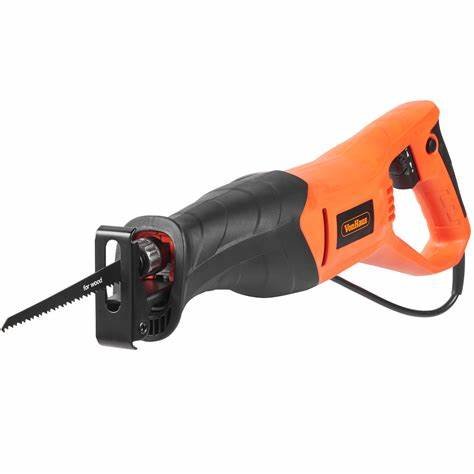Reciprocating saws, often referred to as “re saws” or “saber saws,” are versatile power tools designed to cut through a wide range of materials, from wood and metal to plastic and tile. Their reciprocating blade movement, combined with their powerful motors, allows them to make intricate and precise cuts in tight spaces where a circular saw might struggle.
Understanding the Basics
A typical reciprocating saw consists of the following components:
Motor: The heart of the saw, providing the power to drive the blade.
Reciprocating mechanism: A linkage system that converts rotational motion from the motor into a back-and-forth motion.
Blade: A narrow, toothed blade that oscillates back and forth to cut through materials.
Shoe: A metal plate that guides the blade and helps prevent kickback.
Trigger: The switch that controls the saw’s power.
Types of Reciprocating Saws
There are several types of reciprocating saws available, each with its own unique features and applications:
Corded reciprocating saws: These saws are powered by an electrical outlet and offer the most power and durability. They are ideal for heavy-duty tasks, such as cutting through thick metal or concrete.
Cordless reciprocating saws: Powered by rechargeable batteries, these saws are portable and convenient for jobs on the go. They are suitable for a wide range of applications, including home improvement projects and outdoor tasks.
Variable-speed reciprocating saws: These saws allow you to adjust the blade speed to match the material you are cutting. This feature is particularly useful for delicate materials, such as thin sheet metal or plastic.
Orbital reciprocating saws: These saws have a dual action, combining a back-and-forth motion with a slight orbital movement. This action helps to create a smoother cut and reduce vibration.
Choosing the Right Blade
The type of blade you use will significantly impact the performance of your reciprocating saw.
Wood blades: These blades have a coarse tooth pitch and are ideal for cutting through wood.
Metal blades: These blades have a fine Impact Driver tooth pitch and are designed for cutting through metal.
Bi-metal blades: These blades have a bimetallic construction, combining a high-speed steel cutting edge with a flexible backing. They are versatile and can be used to cut through a variety of materials.
Demolition blades: These blades have a wide tooth pitch and are designed for heavy-duty demolition work.
Safety Tips for Using a Reciprocating Saw
Wear protective gear: Always wear safety glasses, hearing protection, and gloves when using a reciprocating saw.
Use a stable work surface: Ensure that your workpiece is securely clamped to a stable work surface.
Avoid kickback: Always hold the saw firmly and avoid cutting into materials at an angle.
Inspect the blade regularly: Check for damage to the blade before each use.
Disconnect the power: Unplug the saw or remove the battery before changing the blade or performing maintenance.
Common Reciprocating Saw Applications
Reciprocating saws are versatile tools with a wide range of applications, including:
Home improvement projects: Cutting wood for framing, trim, and cabinetry.
Demolition work: Removing drywall, flooring, and other materials.
Metalworking: Cutting through pipes, sheet metal, and other metals.
Outdoor tasks: Pruning trees, cutting branches, and clearing brush.
Automotive repair: Cutting through metal components and removing rusted parts.
Reciprocating Saw Maintenance
Proper maintenance is essential for keeping your reciprocating saw in good working condition. Here are some tips for maintaining your saw:
Clean the saw regularly: Remove any sawdust or debris from the saw’s body and blade.
Lubricate the moving parts: Apply a light lubricant to the reciprocating mechanism and other moving parts.
Inspect the blade for damage: Check for cracks, chips, or other damage to the blade.
Replace the blade regularly: Replace the blade when it becomes dull or damaged.
Store the saw properly: Store the saw in a dry, secure location.
Blade Technology and Innovations
While the basic design of reciprocating saws has remained relatively unchanged for decades, significant advancements have been Stick-On Tiles made in blade technology. Here are some notable innovations:
Laser-cut blades: These blades are cut with laser precision, resulting in a sharper edge and longer lifespan.
Bi-metal blades with permalloy: Permalloy is a magnetic alloy that helps to reduce vibration and improve cutting performance.
Demolition blades with tungsten carbide tips: These blades are incredibly durable and can cut through tough materials like concrete and masonry.
Flush-cutting blades: These blades have a special design that allows them to make flush cuts without leaving any overhang.
Cordless Technology and Battery Performance
The development of powerful lithium-ion batteries has revolutionized cordless reciprocating saws. These batteries offer longer runtimes, faster charging times, and improved durability compared to older battery technologies. As battery technology continues to advance, we can expect to see even more powerful and versatile cordless reciprocating saws in the future.
Safety Features
Safety is a top priority when using a reciprocating saw. Manufacturers have implemented various safety features to reduce the risk of accidents, including:
Lock-on triggers: These triggers prevent accidental activation of the saw.
Anti-kickback mechanisms: These mechanisms help to prevent the saw from jumping out of the user’s control.
Dust shrouds: These shrouds help to protect the user from exposure to harmful dust particles.
Frequently Asked Questions
What is a reciprocating saw?
A reciprocating saw, also known as a saber saw, is a power tool used for cutting through a variety of materials, including wood, metal, and plastic. It has a reciprocating blade that moves back and forth to create a cutting action.
What can I use a reciprocating saw for?
Reciprocating saws are versatile tools that can be used for a variety of tasks, including home improvement projects, demolition work, metalworking, outdoor tasks, and automotive repair.
What is the average lifespan of a reciprocating saw?
The lifespan of a reciprocating saw depends on the quality of the tool, how it is used, and how well it is maintained. With proper care, a reciprocating saw can last for many years.
Final Thoughts
Reciprocating saws are essential tools for homeowners, DIY enthusiasts, and professionals alike. Their versatility, power, and precision make them ideal for a wide range of cutting tasks. By understanding the different types of saws, blades, and safety tips, you can choose the right tool for your needs and use it safely and effectively.
To read more, Click Here


